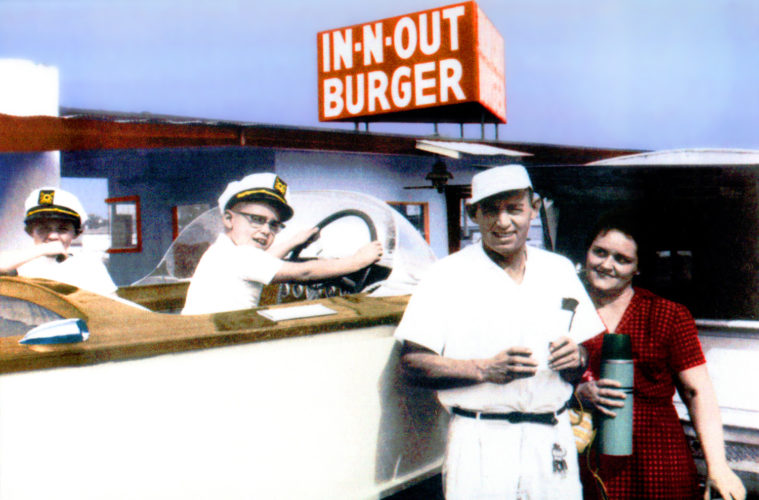 One of the first things George Geary and I discovered about each other is that we are both California natives. “If they say they’re a native we don’t believe ’em. They think if they’ve stayed here longer than three weeks they’re a native.”
One of the first things George Geary and I discovered about each other is that we are both California natives. “If they say they’re a native we don’t believe ’em. They think if they’ve stayed here longer than three weeks they’re a native.”
George grew up in Santa Monica and I grew up in the San Francisco Bay Area. His new book, Made In California: The California-Born Burger Joints, Diners, Fast Food & Restaurants That Changed America tells the history of the landmark eateries that shaped the way we eat. When he was putting it together, he was stunned to learn no one else had done something similar.
I asked him about Doggie Diner, a place I remember fondly from my San Francisco childhood that isn’t a part of this book. He wasn’t familiar with it but said he’d check it out. He already has plans for a volume two with another 50 – 60 food joints.
 Another entry that leapt out at me was Sambo’s. I remember many family visits to Sambo’s as a child, mostly for breakfast. Founded in 1957 by Sam Battistone and Newell “Bo” Bohnett, it wasn’t until a year later that they started incorporating the children’s book “Little Black Sambo” into the restaurants’ theme. Sambo was an Indian boy who was bullied out of his clothes by tigers. The tigers eventually chased each other around a tree until they melted into butter. Innocent enough, right? In the 1970s there were more than 1,000 Sambo’s nationwide, featuring pancakes and “tiger butter” with decor based on the book. Sambo, however, was considered a racist name for black males. People started saying ‘oh, that’s that racist place.’ Despite the fact the name was a contraction of the owners’ names, public outcry forced the company to sell the chain to a large corporation. Most of the restaurants were renamed “Seasons”. 600 eventually became Denny’s.
Another entry that leapt out at me was Sambo’s. I remember many family visits to Sambo’s as a child, mostly for breakfast. Founded in 1957 by Sam Battistone and Newell “Bo” Bohnett, it wasn’t until a year later that they started incorporating the children’s book “Little Black Sambo” into the restaurants’ theme. Sambo was an Indian boy who was bullied out of his clothes by tigers. The tigers eventually chased each other around a tree until they melted into butter. Innocent enough, right? In the 1970s there were more than 1,000 Sambo’s nationwide, featuring pancakes and “tiger butter” with decor based on the book. Sambo, however, was considered a racist name for black males. People started saying ‘oh, that’s that racist place.’ Despite the fact the name was a contraction of the owners’ names, public outcry forced the company to sell the chain to a large corporation. Most of the restaurants were renamed “Seasons”. 600 eventually became Denny’s.
A & W’s roots are in Lodi. There’s a plaque in the sidewalk where the original location stood. When it first opened the store was simply called “Root Beer.” A & W still has a large presence in Canada.
I asked George if anything he found while doing his research surprised him. What he learned about Swensen’s he said, did surprise him. There used to be a Swensen’s in nearly every town. They were bigger than Baskin Robbins. Corporate at one point decided that rather than continue making their own ice cream, they’d simply buy it. Franchisees were told to sell their equipment. Today, only three Swensen’s remain in America. There are 600 in Asia.
He learned some companies changed their core values. For the first twenty years they were in business, you could be assured of getting a burger hot off the grill from McDonald’s. That changed to a burger that sat in styrofoam under warming lamps for up to twenty minutes. Now you’re likely to get a burger that’s been sitting in boiling water. George believes companies should stick to what made them famous in the first place.
 His intent was to write a book that told the story, what businesses invented and what directions they have taken. He didn’t want it to be negative in tone. The only really negative part in the book is when he shares the story of the plane crash that took the lives of two In-N-Out’s management team in 1993. The story was too well known for him to omit it.
His intent was to write a book that told the story, what businesses invented and what directions they have taken. He didn’t want it to be negative in tone. The only really negative part in the book is when he shares the story of the plane crash that took the lives of two In-N-Out’s management team in 1993. The story was too well known for him to omit it.
I found this book fascinating, and the care the author took to breathe life into these stories is evident. At the beginning of the book, he recalls his dad teaching him when he was six years old, how to eat a Foster’s Freeze dipped cone without messing his shirt. George told me he always knows who each book he writes will be dedicated to before he writes it. He doesn’t share that fact with the publisher, however, until the book is finished. He calls that his good luck charm.
He’s at work on his next book now, volume two of LA’s Legendary Restaurants. I for one can’t wait to read it.

